Urban Boundary Demarcation—An iCN Model Approach
Abstract
:1. Introduction
1.1. Theoretical Background of the Urban Boundary Demarcation
1.2. Existing Applications, Limitations and Failures
1.3. Application of the iCN Model to Identify Urban Boundaries
2. Materials and Methods
2.1. Study Area
2.2. Data Description and Sources
2.3. Method of Study
2.4. iCN Model Implementation
2.5. Model Validation
3. Analysis and Results
3.1. Application of the iCN Model
3.2. Urban Boundaries Derived from City Clusters
3.3. Empirical Test of the Model Result
3.4. Model Validation
4. Discussion and Conclusions
5. Recommendations and Model Availability
6. Limitations and Future Work
Author Contributions
Funding
Institutional Review Board Statement
Informed Consent Statement
Data Availability Statement
Acknowledgments
Conflicts of Interest
References
- Arcaute, Elsa, Erez Hatna, Peter Ferguson, Hyejin Youn, Anders Johansson, and Michael Batty. 2015. Constructing cities, deconstructing scaling laws. Journal of the Royal Society Interface 12: 20140745. [Google Scholar] [CrossRef] [PubMed]
- Arcaute, Elsa, Carlos Molinero, Erez Hatna, Roberto Murcio, Camilo Vargas-Ruiz, A. Paolo Masucci, and Michael Batty. 2016. Cities and regions in Britain through hierarchical percolation. Royal Society Open Science 3: 150691. [Google Scholar] [CrossRef] [Green Version]
- Batty, Michael, and Paul A. Longley. 1994. Fractal Cities: A Geometry of Form and Function. Cambridge: Academic Press. [Google Scholar]
- Briggs, David J., John Gulliver, Daniela Fecht, and Danielle M. Vienneau. 2007. Dasymetric modelling of small-area population distribution using land cover and light emissions data. Remote Sensing of Environment 108: 451–66. [Google Scholar] [CrossRef]
- Chakraborti, Suman, Dipendra Nath Das, Biswajit Mondal, Hossein Shafizadeh-Moghadam, and Yongjiu Feng. 2018. A neural network and landscape metrics to propose a flexible urban growth boundary: A case study. Ecological Indicators 93: 952–65. [Google Scholar] [CrossRef]
- Chen, Jiandong, Wei Fan, Ke Li, Xin Liu, and Malin Song. 2019. Fitting Chinese cities’ population distributions using remote sensing satellite data. Ecological Indicators 98: 327–33. [Google Scholar] [CrossRef]
- de Rijke, Chris A., Gloria Macassa, Mats Sandberg, and Bin Jiang. 2020. Living Structure as an Empirical Measurement of City Morphology. ISPRS International Journal of Geo-Information 9: 677. [Google Scholar] [CrossRef]
- Dijkstra, Lewis, Teodora Brandmüller, Thomas Kemper, Arbab Asfandiyar, and Paolo Veneri. 2021. Applying the Degree of Urbanisation—n—A Methodological Manual to Define Cities, Towns and Rural Areas for International. Luxembourg: Publications Office of the European Union. [Google Scholar]
- Dong, Nan, Xiaohuan Yang, Hongyan Cai, and Liming Wang. 2015. A novel method for simulating urban population potential based on urban patches: A case study in Jiangsu Province, China. Sustainability 7: 3984–4003. [Google Scholar] [CrossRef] [Green Version]
- Eicher, Cory L., and Cynthia A. Brewer. 2001. Dasymetric mapping and areal interpolation: Implementation and evaluation. Cartography and Geographic Information Science 28: 125–38. [Google Scholar] [CrossRef]
- Gismondi, M., C. Kamusoko, T. Furuya, S. Tomimura, and M. Maya. 2013. MOLUSCE—An an open source land use change analyst. In FOSS4G OSGeo’s Global Conference for Open Source Geospatial Software. Nottingham: Birleşik Krallık. [Google Scholar]
- Hagen-Zanker, Alex. 2009. An improved Fuzzy Kappa statistic that accounts for spatial autocorrelation. International Journal of Geographical Information Science 23: 61–73. [Google Scholar] [CrossRef] [Green Version]
- Henriques, Cristina, Alexandre Domingues, and Margarida Pereira. 2020. What Is Urban after All? A Critical Review of Measuring and Mapping Urban Typologies in Portugal. ISPRS International Journal of Geo-Information 9: 630. [Google Scholar] [CrossRef]
- Hillier, Bill, and Laura Vaughan. 2007. The city as one thing. Progress in Planning 67: 205–30. [Google Scholar]
- Hillier, Bill, and Shinichi Iida. 2005. Network effects and psychological effects: A theory of urban movement. In 5th International Symposium on Space Syntax. Delft: TU Delft, pp. 553–64. [Google Scholar]
- Jayasinghe, Amila, Kazushi Sano, and Hiroaki Nishiuchi. 2015. Explaining traffic flow patterns using centrality measures. International Journal for Traffic and Transport Engineering 5: 134–49. [Google Scholar] [CrossRef] [Green Version]
- Jayasinghe, Amila, N. B. S. Madusanka, Chethika Abenayake, and P. K. S. Mahanama. 2021. A Modeling Framework: To Analyze the Relationship between Accessibility, Land Use and Densities in Urban Areas. Sustainability 13: 467. [Google Scholar] [CrossRef]
- Jiang, Bin, and Chengke Liu. 2009. Street-based topological representations and analyses for predicting traffic flow in GIS. International Journal of Geographical Information Science 23: 1119–37. [Google Scholar] [CrossRef] [Green Version]
- Jiang, Bin, and S. Anders Brandt. 2016. A fractal perspective on scale in geography. SPRS International Journal of Geo-Information 5: 95. [Google Scholar] [CrossRef] [Green Version]
- Jiang, Bin, and Terry Slocum. 2020. A map is a living structure with the recurring notion of far more smalls than larges. ISPRS International Journal of Geo-Information 9: 388. [Google Scholar] [CrossRef]
- Japan International Cooperation Agency. 2014. Urban Transport System Development Project for Colombo Metropolitan Region and Suburbs; Colombo: Japan International Cooperation Agency.
- Lindamullage Don Charls Hasintha Nawod Kalpana, Chethika Abenayake, Amila Jayasinghe, Pelpola KS Mahanama, and Niroshan Sanjaya. 2021. A novel approach to measure the pattern of urban agglomeration based on the road network. International Journal of Sustainable Development and Planning 16: 251–62. [Google Scholar] [CrossRef]
- Lee, Kyung-Young. 2021. Factors Influencing Urban Livability in Seoul, Korea: Urban Environmental Satisfaction and Neighborhood Relations. Social Sciences 10: 138. [Google Scholar] [CrossRef]
- Levin, Lena. 2019. How may public transport influence the practice of everyday life among younger and older people and how may their practices influence public transport? Social Sciences 8: 96. [Google Scholar] [CrossRef] [Green Version]
- Liu, Ting, and Xiaojun Yang. 2015. Monitoring land changes in an urban area using satellite imagery, GIS and landscape metrics. Applied Geography 56: 42–54. [Google Scholar] [CrossRef]
- Ma, Ding, Itzhak Omer, Toshihiro Osaragi, Mats Sandberg, and Bin Jiang. 2019. Why topology matters in predicting human activities. Environment and Planning B: Urban Analytics and City Science 46: 1297–313. [Google Scholar] [CrossRef]
- Masucci, A. Paolo, Elsa Arcaute, Jiaqiu Wang, Erez Hatna, and Michael Batty. 2014. Universal Properties for Urban Street Networks. Paper presented at 2014 Tenth International Conference on Signal-Image Technology and Internet-Based Systems, Marrakech, Morocco, November 23–27. [Google Scholar]
- Mennis, Jeremy. 2003. Generating surface models of population using dasymetric mapping. The Professional Geographer 55: 31–42. [Google Scholar]
- Montero, Gaëtan, Cécile Tannier, and Isabelle Thomas. 2021. Delineation of cities based on scaling properties of urban patterns: A comparison of three methods. International Journal of Geographical Information Science 35: 919–47. [Google Scholar] [CrossRef]
- Mortoja, Md Golam, Tan Yigitcanlar, and Severine Mayere. 2020. What is the most suitable methodological approach to demarcate peri-urban areas? A systematic review of the literature. Land Use Policy 95: 104601. [Google Scholar] [CrossRef]
- Mundhe, Nitin N., and Ravindra G. Jaybhaye. 2014. Impact of urbanization on land use/land covers change using Geo-spatial techniques. International Journal of Geomatics and Geosciences 5: 50–60. [Google Scholar]
- Murcio, Roberto, A. Paolo Masucci, Elsa Arcaute, and Michael Batty. 2015. Multifractal to monofractal. Physical Review E. [Google Scholar] [CrossRef] [Green Version]
- Nicolau, Rita, João David, Mário Caetano, and José Pereira. 2019. Ratio of land consumption rate to population growth rate—Analysis of different formulations applied to mainland Portugal. ISPRS International Journal of Geo-Information 8: 10. [Google Scholar] [CrossRef] [Green Version]
- Peng, Jian, Yi’na Hu, Yanxu Liu, Jing Ma, and Shiquan Zhao. 2018. A new approach for urban-rural fringe identification: Integrating impervious surface area and spatial continuous wavelet transform. Landscape and Urban Planning 175: 72–79. [Google Scholar] [CrossRef]
- Song, Yongze, Ying Long, Peng Wu, and Xiangyu Wang. 2018. Are all cities with similar urban form or not? Redefining cities with ubiquitous points of interest and evaluating them with indicators at city and block levels in China. International Journal of Geographical Information Science 32: 2447–76. [Google Scholar] [CrossRef]
- Sutton, Paul, Dar Roberts, Chris Elvidge, and Henk Meij. 1997. A comparison of nighttime satellite imagery and population density for the continental United States. Photogrammetric Engineering and Remote Sensing 63: 1303–13. [Google Scholar]
- Tian, Yongzhong, Tianxiang Yue, Lifen Zhu, and Nicholas Clinton. 2005. Modeling population density using land cover data. Ecological Modelling 189: 72–88. [Google Scholar] [CrossRef]
- Hu, Xiaofang, Yuguo Qian, Steward TA Pickett, and Weiqi Zhou. 2020. Urban mapping needs up-to-date approaches to provide diverse perspectives of current urbanization: A novel attempt to map urban areas with nighttime light data. Landscape and Urban Planning 195: 103709. [Google Scholar] [CrossRef]
- Zhang, Jingxiong, Peter Atkinson, and Michael F. Goodchild. 2014. Scale in Spatial Information and Analysis. Boca Raton: CRC Press. [Google Scholar]
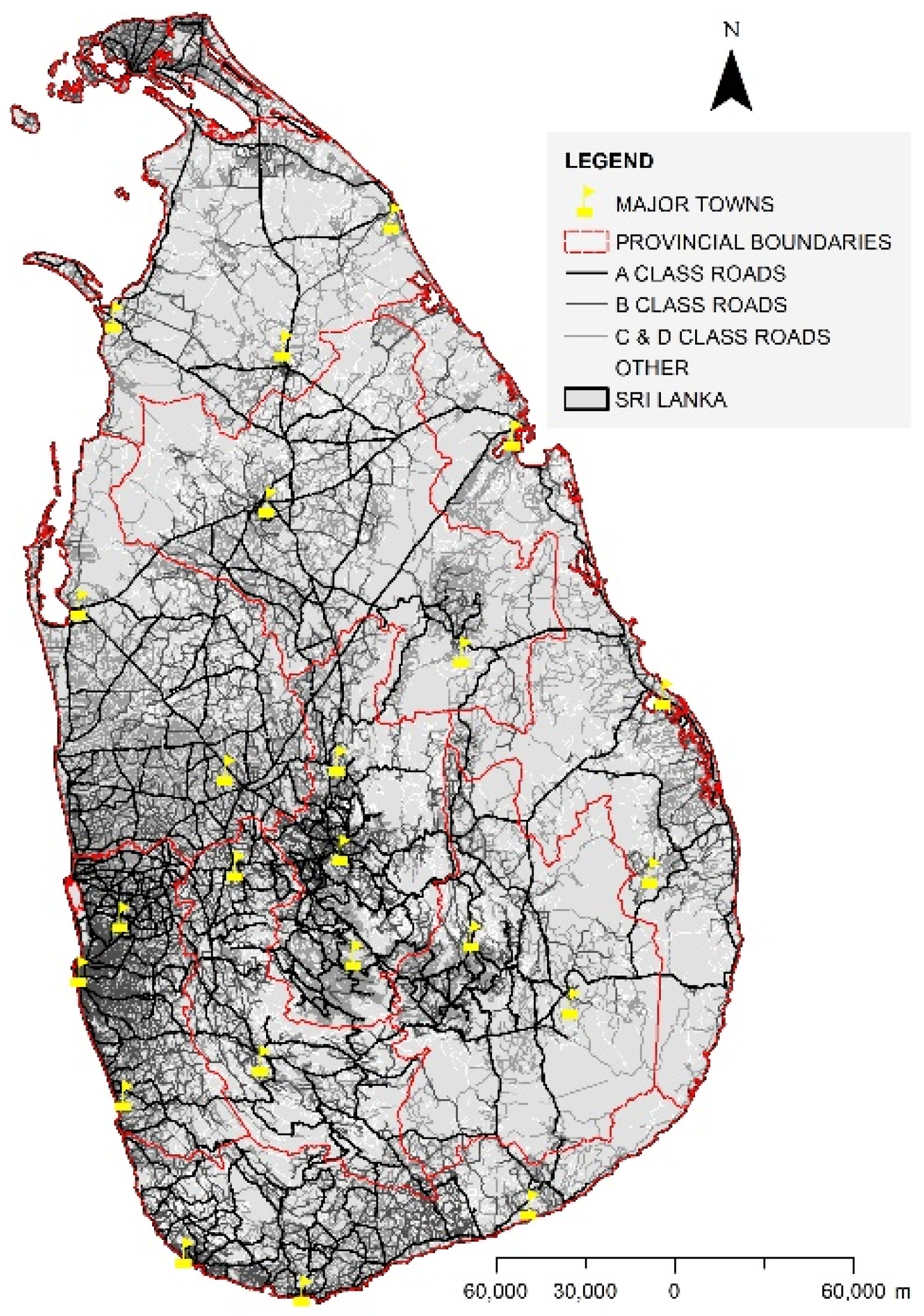
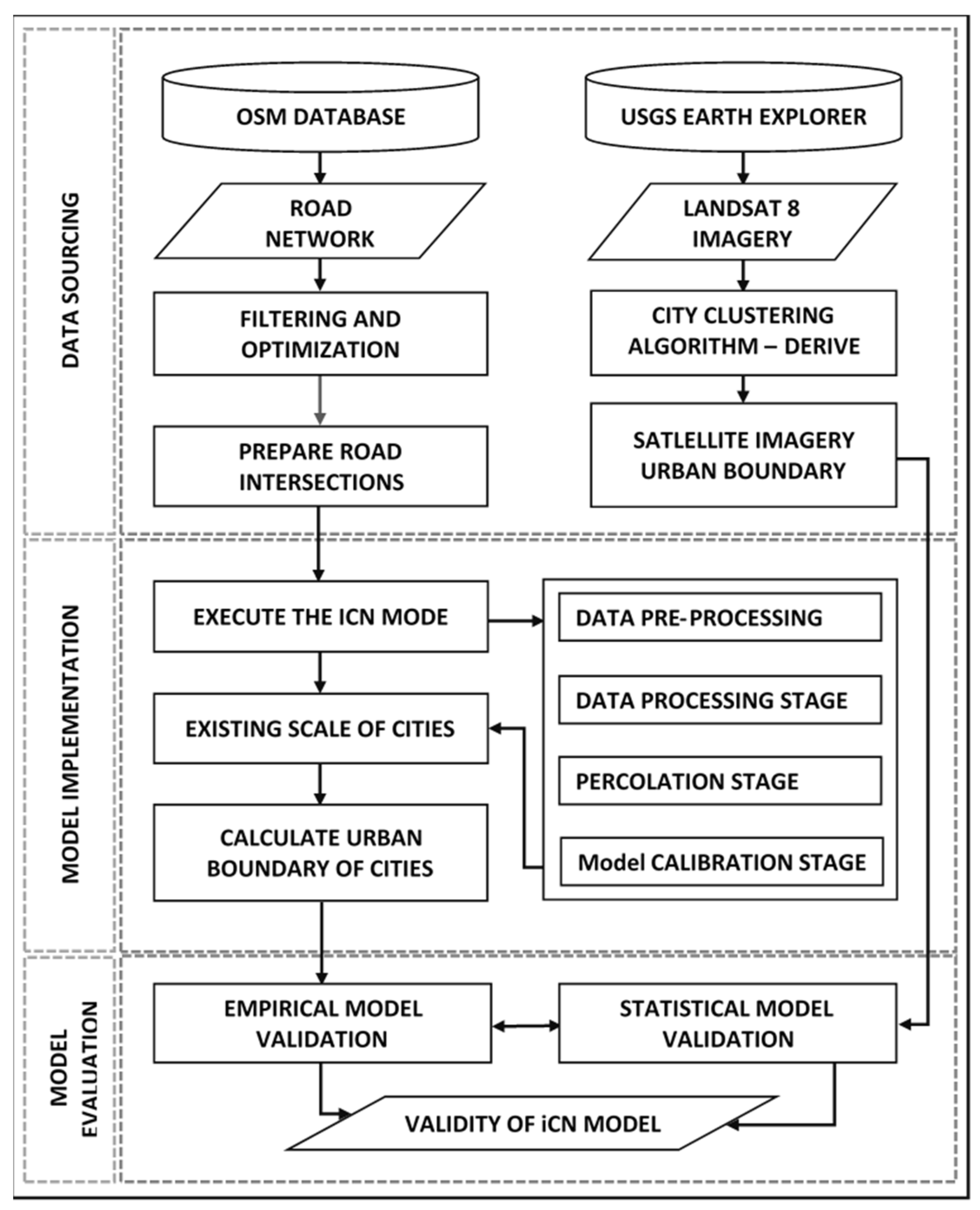
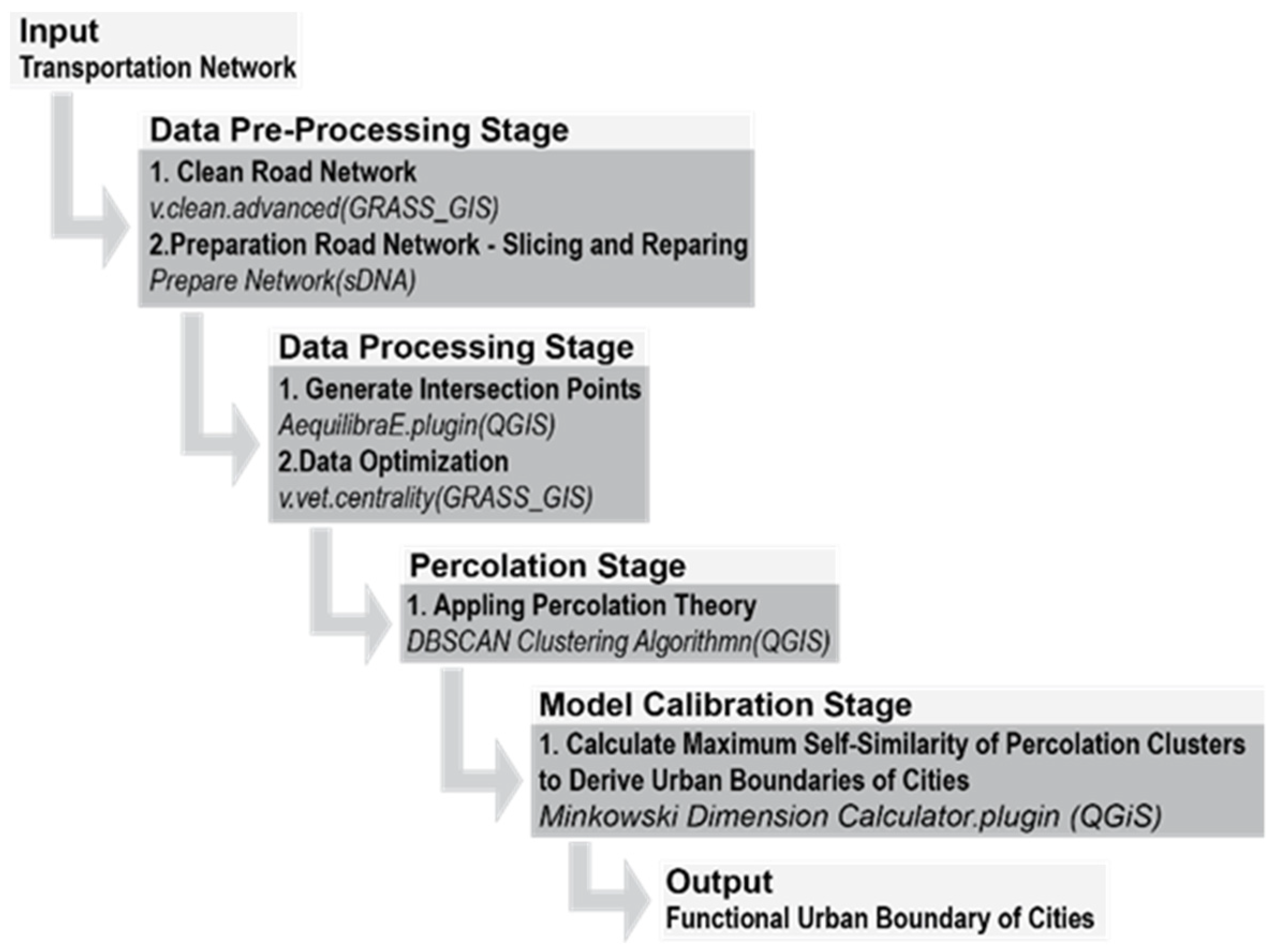

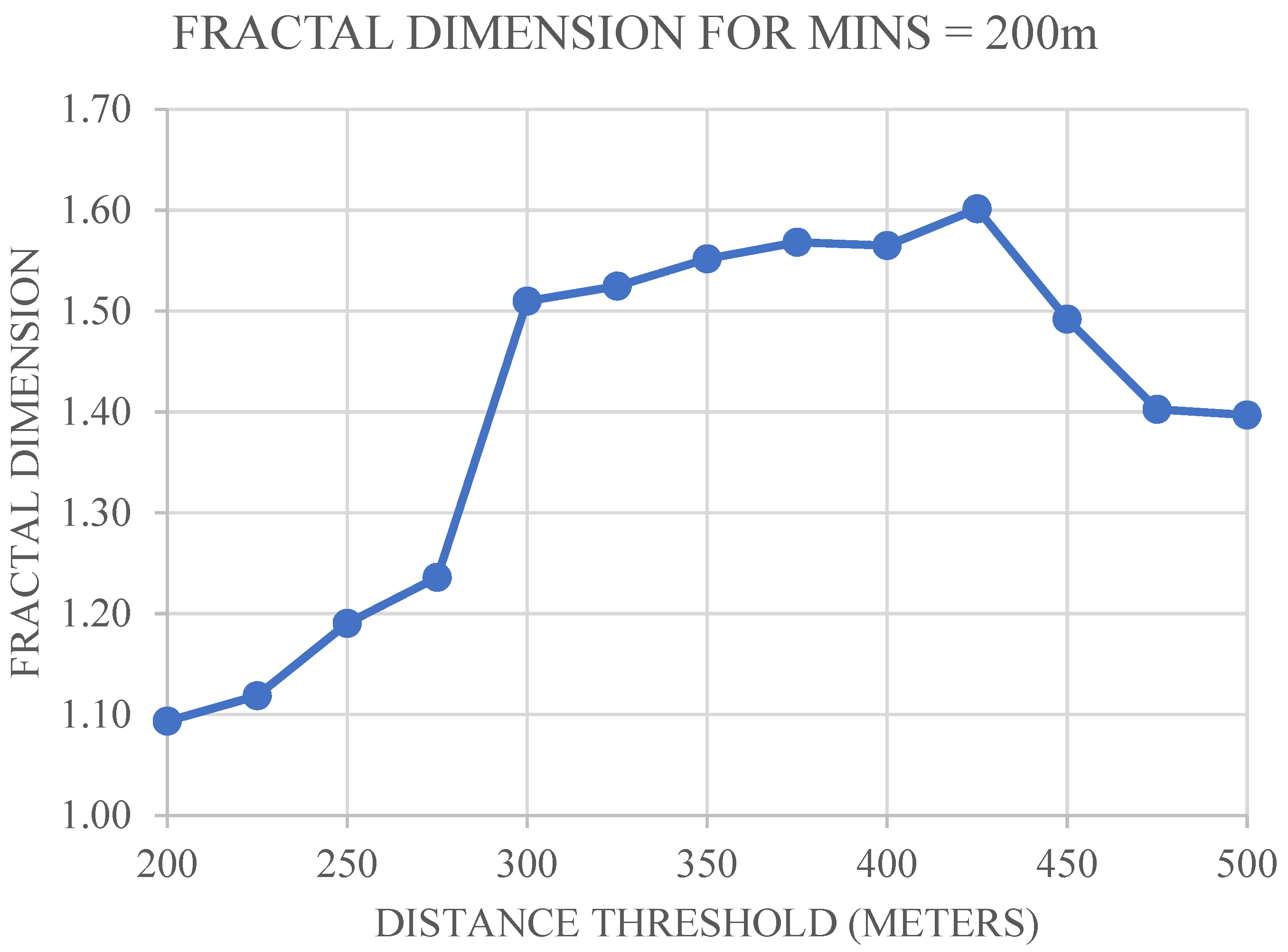
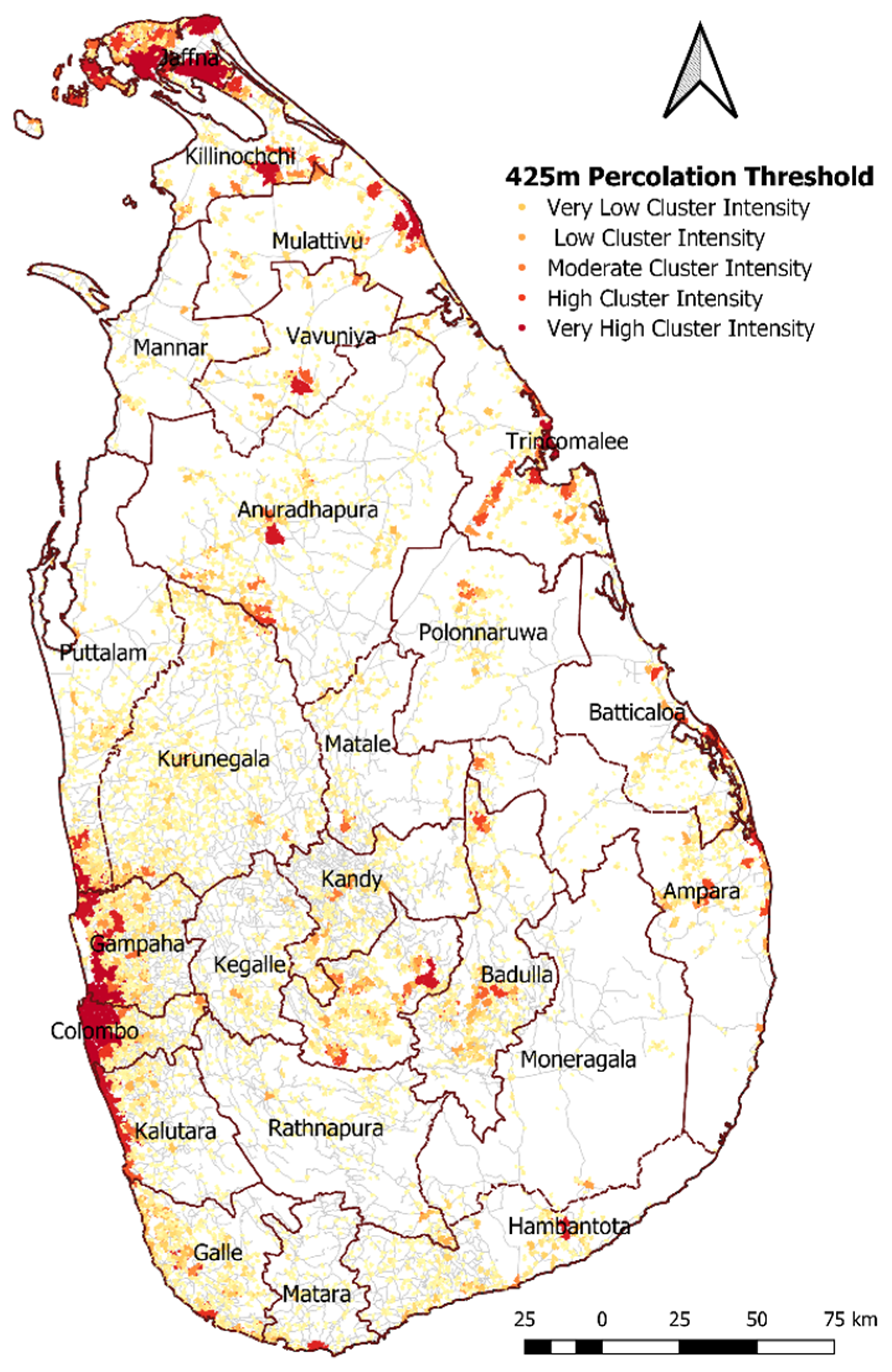
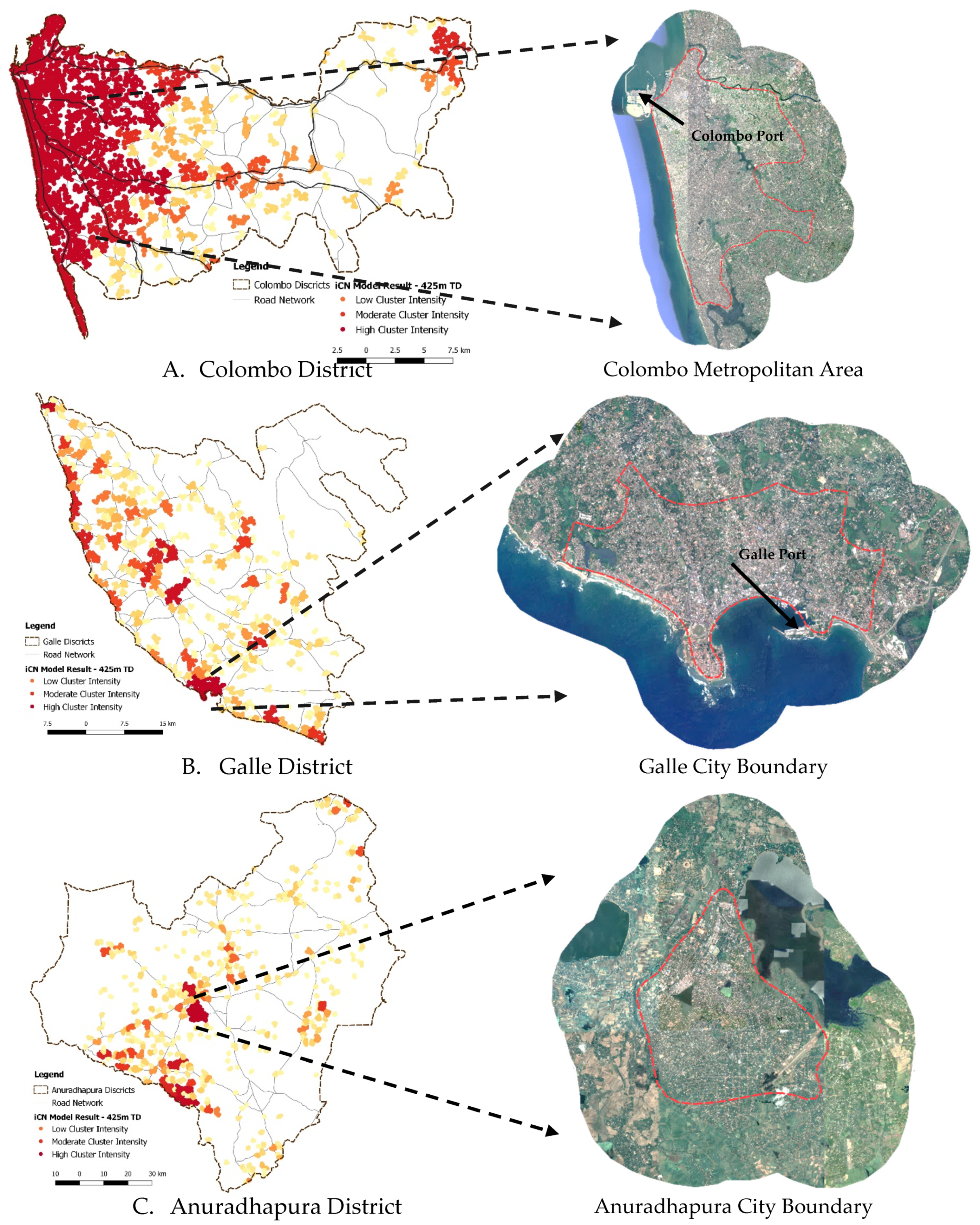
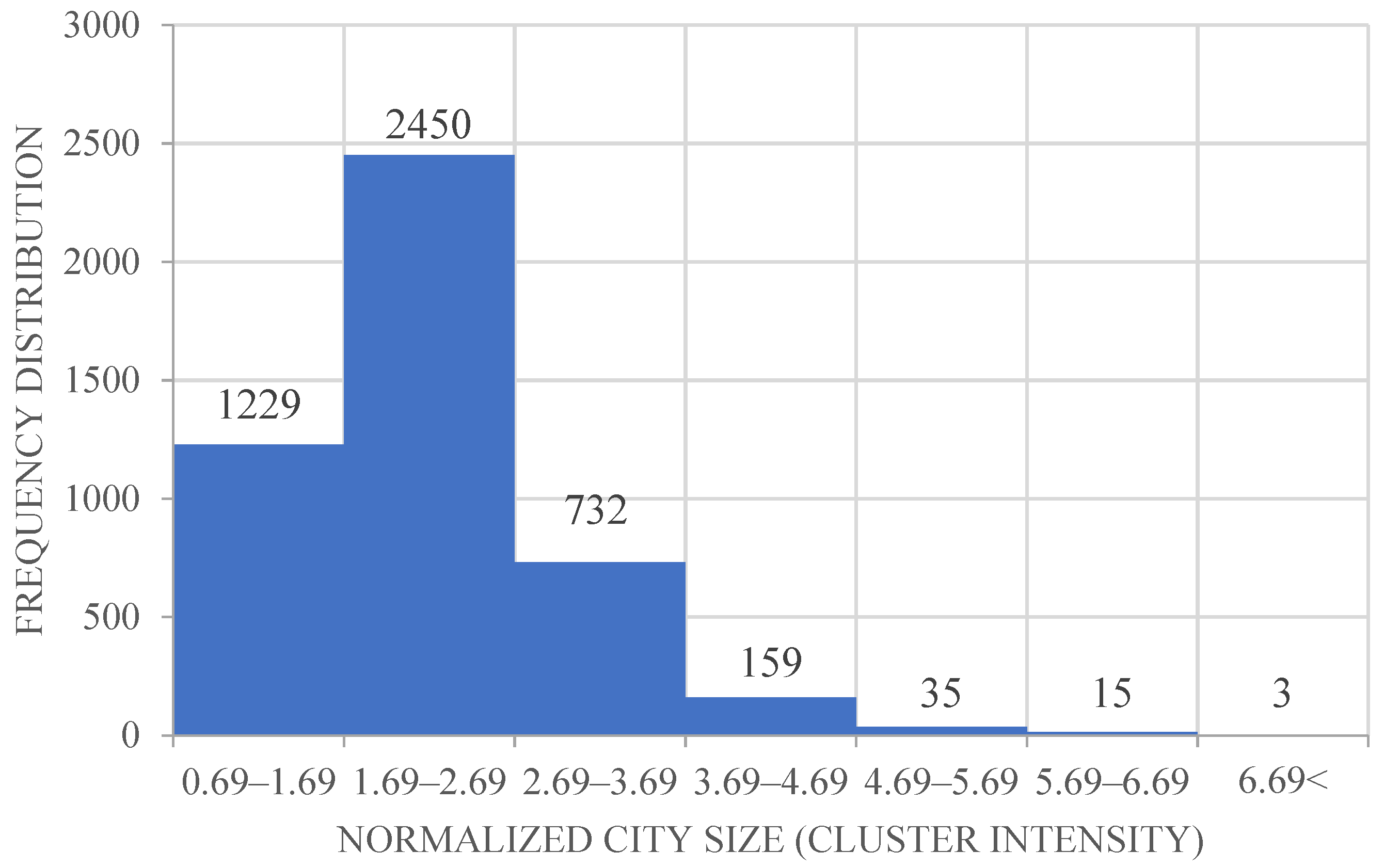


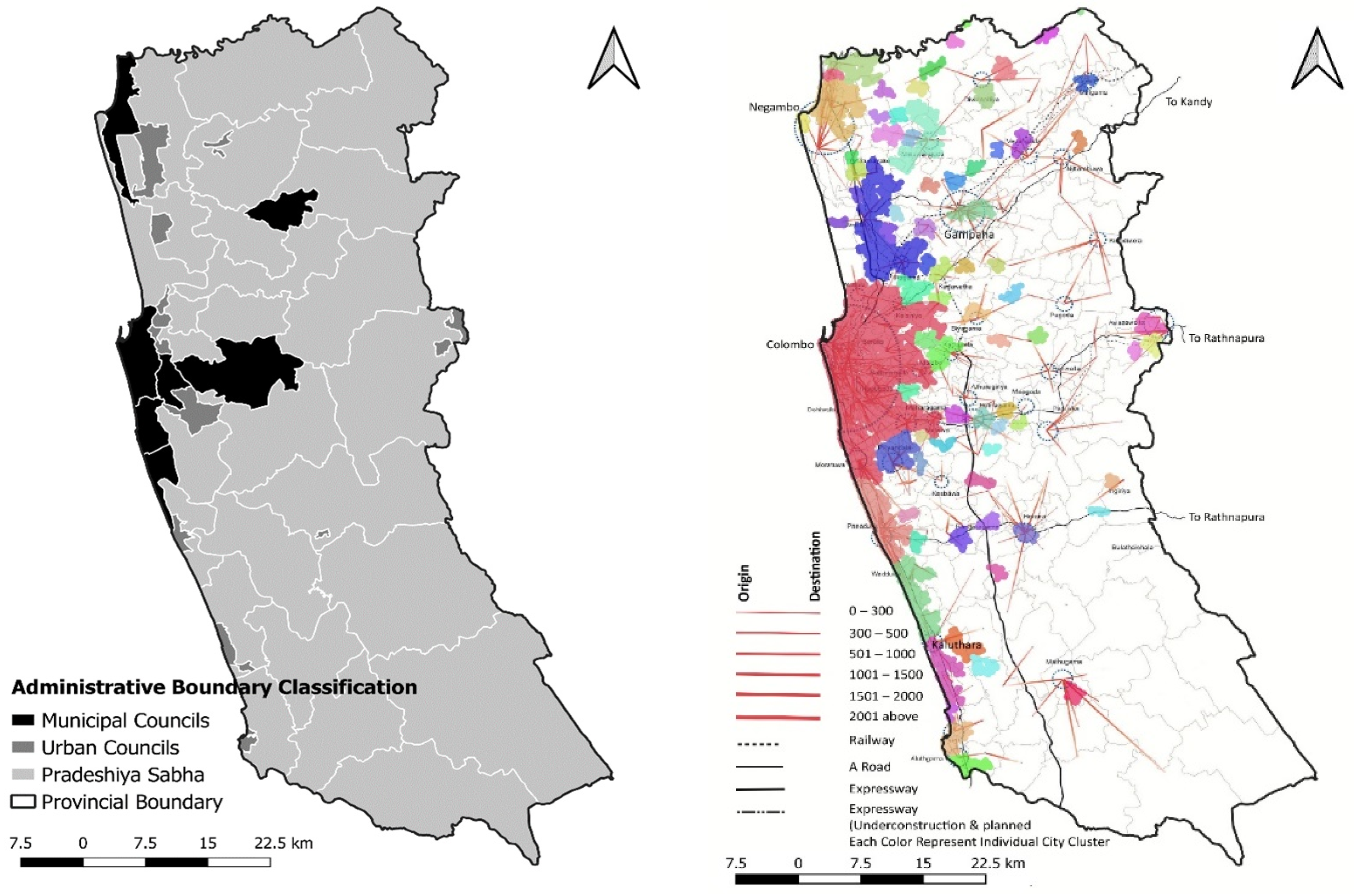
| The Basic Characteristics of Sri Lanka | |
|---|---|
| Total Population | 20,359,439 |
| Total Land Extent | 65,610 Km2 |
| Data Type | Extent | Year | Source | Data Format |
|---|---|---|---|---|
| Road Network | Sri Lanka | 2012 | Open Street Map | GIS data: Vector Format. Dissolved to Individual Polyline |
| Administrative Boundaries | Sri Lanka | 2012 | Survey Department of Sri Lanka | GIS data: Vector Format. Dissolved to Individual Polygon |
| Satellite Imagery | Sri Lanka | 2012 | USGS Earth Explorer | GIS data: Raster Format. Landsat 8. 12 Bands. |
Publisher’s Note: MDPI stays neutral with regard to jurisdictional claims in published maps and institutional affiliations. |
© 2021 by the authors. Licensee MDPI, Basel, Switzerland. This article is an open access article distributed under the terms and conditions of the Creative Commons Attribution (CC BY) license (https://creativecommons.org/licenses/by/4.0/).
Share and Cite
Jayasinghe, A.; Kalpana, L.D.C.H.N.; Abenayake, C.C.; Mahanama, P.K.S. Urban Boundary Demarcation—An iCN Model Approach. Soc. Sci. 2021, 10, 448. https://doi.org/10.3390/socsci10120448
Jayasinghe A, Kalpana LDCHN, Abenayake CC, Mahanama PKS. Urban Boundary Demarcation—An iCN Model Approach. Social Sciences. 2021; 10(12):448. https://doi.org/10.3390/socsci10120448
Chicago/Turabian StyleJayasinghe, Amila, Lindamullage Don Charls Hasintha Nawod Kalpana, Charithmali Chethika Abenayake, and Pelpola Kankanamge Seneviratne Mahanama. 2021. "Urban Boundary Demarcation—An iCN Model Approach" Social Sciences 10, no. 12: 448. https://doi.org/10.3390/socsci10120448
APA StyleJayasinghe, A., Kalpana, L. D. C. H. N., Abenayake, C. C., & Mahanama, P. K. S. (2021). Urban Boundary Demarcation—An iCN Model Approach. Social Sciences, 10(12), 448. https://doi.org/10.3390/socsci10120448






